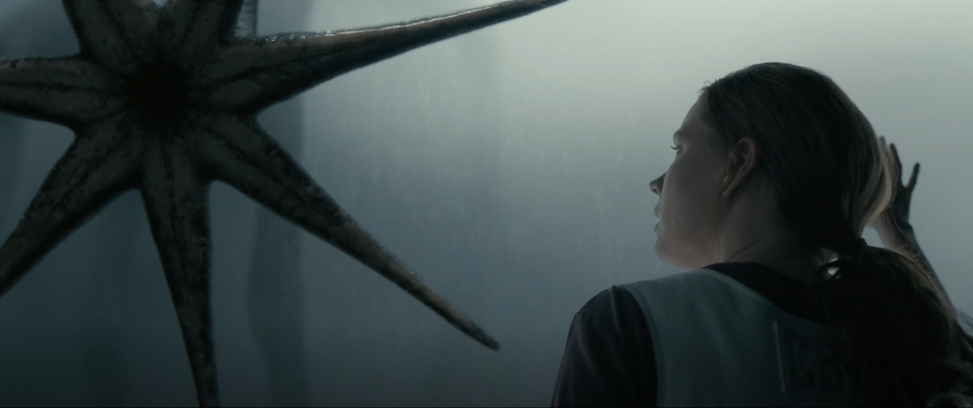Hollywood loves its explosions. The louder, the better. High-speed chases? Of course. A hero dodging bullets in slow motion? Classic. But then there’s Arrival (2016), directed by Denis Villeneuve, which takes all those expectations and tosses them out of the window. This isn’t your typical action-packed, edge-of-your-seat thriller. But somehow, it still keeps you right there, gripping the armrest. The scene at 46:20 is a prime example: Louise Banks (Amy Adams) doesn’t fight an alien but she talks to one. No guns. No running. Just a quiet, almost sacred moment of connection. This essay dives into the scene’s visual storytelling, editing, and deeper meaning, showing how Arrival plays by its own rules and wins.
Mise-en-Scène: The Art of Stillness
Every frame in this scene feels like something. Louise stands on the right, the Heptapod’s long, inky tentacle stretching towards her from the left. Between them? A thick, foggy glass wall. They’re separate. Yet, somehow, still connected. The lighting? Dim. Heavy. Like the air itself is thick with meaning. The Heptapod isn’t some snarling, monstrous alien. It’s shadowy, elegant, almost ghostly. There’s no chaos. No screaming. Just a single moment, stretched out like a held breath. Funny how a movie about language can make silence so powerful.
Editing & Cinematic Style: Slow but Sure
Ever notice how action movies cut fast? One second you see the hero’s face, the next—BAM—explosions, punches, chaos. But not here. This scene takes its time. The camera lingers, lets us feel the moment. No frantic cutting back and forth, no shaky cam. Just long takes, deliberate shifts between Louise’s perspective and the alien’s looming form. It’s like the film is whispering, Slow down. Pay attention. And because we do, the tension? Almost unbearable.
Who’s in Charge? Gender, Race, and Representation
Let’s be real: if this were any other Hollywood blockbuster, some rugged, square-jawed guy would be leading the charge, gun in hand, throwing out one-liners. But Arrival? It gives us Louise. A woman. A linguist. Not a soldier, not a fighter. Just someone who listens. And instead of treating the aliens as monstrous invaders, the film makes them wise, mysterious—far from the usual “us vs. them” trope. It flips the script in the best way possible.
Violence Without Violence: A Different Kind of Action
Here’s the thing, this scene? It’s tense. Not because something’s blowing up. Not because there’s a fight. But because there might be. The military’s ready to attack. The world is on edge. And yet, in this moment, it’s just Louise and the Heptapod. Talking. Understanding. Sometimes, the most gripping action isn’t about what happens, it’s about what might happen.
How Arrival Breaks the Rules of Action Cinema
Fast cuts. Shaky cameras. Constant movement. That’s what we expect from action films, right? David Bordwell (2006) calls it “intensified continuity” basically, the idea that movies keep getting faster to hold our attention. But Villeneuve? He does the opposite. He slows us down. Makes us wait. Kristin Thompson (2013) says most action films need constant movement to stay engaging. Arrival proves that sometimes, stillness is just as captivating.
The Box Office Scorecard
Did it work? Oh, absolutely. Arrival raked in about $203 million worldwide on a $47 million budget (Box Office Mojo, 2016). Proof that you don’t need explosions and gunfights to fill theaters. Smart, thoughtful sci-fi? It sells.
The Real-World Impact of Movies Like This
We’ve all seen movies where violence is the answer to everything. But what happens when we watch that over and over again? Anderson et al. (2003) found that repeated exposure to on-screen violence can make aggression seem normal. Arrival takes a different route. It suggests that maybe, just maybe, communication is more powerful than conflict. And in a world where misunderstandings spiral into wars, that’s a message worth paying attention to.
Conclusion
The scene in Arrival at 46:20 is a great example of how to be intense without being loud. It raises the tension without dropping a single punch thanks to its breathtaking sights, thoughtful pace, and defiance of the standard action-movie formula. Villeneuve demonstrates that true power comes from comprehension rather than from weapons or explosions. And it’s possible that we need more of that type of activity.
References
• Anderson, C. A., Berkowitz, L., Donnerstein, E., Huesmann, L. R., Johnson, J. D., Linz, D., … & Wartella, E. (2003). “The influence of media violence on youth.” Psychological Science in the Public Interest, 4(3), 81-110.
• Bordwell, D. (2006). The Way Hollywood Tells It: Story and Style in Modern Movies. University of California Press.
• King, G. (2000). Spectacular Narratives: Hollywood in the Age of the Blockbuster. IB Tauris.
• Thompson, K. (2013). “The Future of Editing in Action Cinema.” Journal of Film and Video, 65(2-3), 23-38.
• Box Office Mojo. (2016). Arrival (2016) – Box Office Performance. Retrieved from https://www.boxofficemojo.com/


Stephano Gargurevich
This analysis of the movie Arrival offers a rather detailed breakdown of how the film challenges the usual depiction of action by using stillness and tension as drivers to their narrative, making this whole essay a rather interesting read even while not being focused on an action movie.
I find that the image used also supports their message during the whole essay, the stunning visual giving a clear indication of how strong feelings can be fomented in the audience even without chaotic visuals and a heavy focus in the environment being destroyed or mayorly altered.
Using Bordwell’s “intensified continuity” and the subversion of gender conventions, the essay does a great job at skillfully linking the film’s slower pacing and aesthetic decisions to more general cinematic tactics. While I consider that these points are important to the main argument and well explained, a more thorough examination would strengthen the essay even further. For instance, more focus could have been given on how Arrival’s minimalistic cinematography conveys meaning or how the camera is used to hide or focus on certain things the director wants us to pay attention to, all in hopes of maintaining the suspense without sacrificing the clarity of the story itself.
Overall, this is a thoughtful and well-organized analysis that has a healthy balance of personal interpretation and a scholarly background, the main points that could be improved being the inclusion of more scholarly sources and maybe an approach that compares how the thriller and suspense genre differs from Hollywood action movies, the topic most other essays focused on.